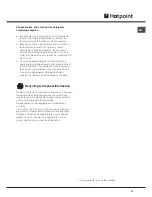
14
EN
Whenever the appliance fails to work, check for a solution from the following list before calling for Assistance
(
see Assistance
).
Troubleshooting
Malfunction: Possible
causes
/
Solutions:
The dishwasher does not start.
• The pl ug has not b een i nserted i nto t he el ectrical socket pr operly, or
ther e is no pow er i n t he house.
• The dis hw asher door has not been shut properl y.
• A delayed start has been programmed (
see St art-up and us e
).
No water drains out from the
dishwasher.
• The dis hwasher cycle has not yet fi nished.
• The w ater outl et hose is bent (
see I nstall ation
).
• The dr ai n duct is blocked.
• The filter is clogged up wit h food r esidues.
The dishw asher makes
excessive noise.
• The dis hes are r at tling against eac h ot her or against t he s prayer
arms.
• An exc essive am ou nt of foam has been produced: the det ergent has
not been m eas ured out cor rectly or it is not suit abl e f or use i n
dishw ashers (
see Start -up and use
).
The dishes and g lasses are
covered in a w hi te film or
limescale deposi ts.
• The level of t he r efined sal t is low or the dos age setti ng is not
suited to t he har dness of t he wat er (
see Rins e ai d and salt
).
• The lid on the salt dispens er is not clos ed pr operly.
• The rins e ai d has b een used up or t he dosage is too l ow.
• The crockery is m ade from non-stick materi al.
The dishes and g lasses are
streaked or ha ve a b luis h
tinge.
• The rins e ai d dosage is too high.
The crockery has not been dried
properly.
• The rins e ai d has b een used up or t he dosage is too l ow (
see Ri nse
aid and salt
).
• The rins e ai d dis penser set ting is not high enough.
• A was h cycle witho ut a dryi ng programm e has been sel ected.
The dishes are n ot clea n.
• The racks are over l oaded (
see Loadi ng the racks
).
• The crockery has n ot been arranged well.
• The spr ayer arms cannot m ove freel y.
• The w ash cycl e is too gentl e (
see W ash cycles
).
• An exc essive am ou nt of foam has been produced: the det ergent has
not been m eas ured out cor rectly or it is not suit abl e f or use i n
dishw ashers (
see Start -up and use
).
• The lid on the rins e ai d compartment has not been s hut correctly.
• The filter is dirt y or blocked (
see Car e and maint enance
).
• The refi ned salt l e vel is low (
see Ri nse ai d and salt
).
No water enters the
dishwasher/Shut off tap alarm.
(several short beeps are emitted)
(the 2 (Normal) and 3 (Soak) WASH
CYCLES indicator lights flash).
• There is no w at er i n t he m ains suppl y.
• The w ater i nlet h ose is bent (
see Inst allati on
).
• Tur n on the t ap an d t he appliance will start aft er a f ew minutes.
• The appliance l ock has been activated bec aus e no acti on w as taken
when t he beeps so unded. Switch off the m achi ne, using t he ON/O FF
butt on, t urn on the tap and switch the m achi ne back on after 20
seconds by pr essin g the same butt on. Re- programme the m achi ne
and rest art the w as h cycle.
Water loading solenoid valve
malfunction alarm
(the 2 (Normal) WASH CYCLE
indicator lights flash).
• Switch off the m ac hi ne by pressing the O N/OF F butt on and switch it
back on aft er a min ute. If t he al arm continues, tur n off the w at er tap
to reduc e the risk of floodi ng, r em ove the plug from the el ectrical
socket and call As sistance.
Water inlet hose alarm/Water inlet
filter blocked.
(the 1 (Intensive), the 2 (Normal) and
the 3 (Soak) WASH CYCLES
indicator lights flash).
• Switch off the appl iance by pressing the O N/OFF butt on. Shut off
the wat er tap to el imi nat e t he risk of flooding and rem ove the plug
from the el ectrical socket.
Make sur e the w at er inl et fi lter has not becom e bl ocked by vari ous
impurities. (see “C ar e and mai ntenance” chapter).


































